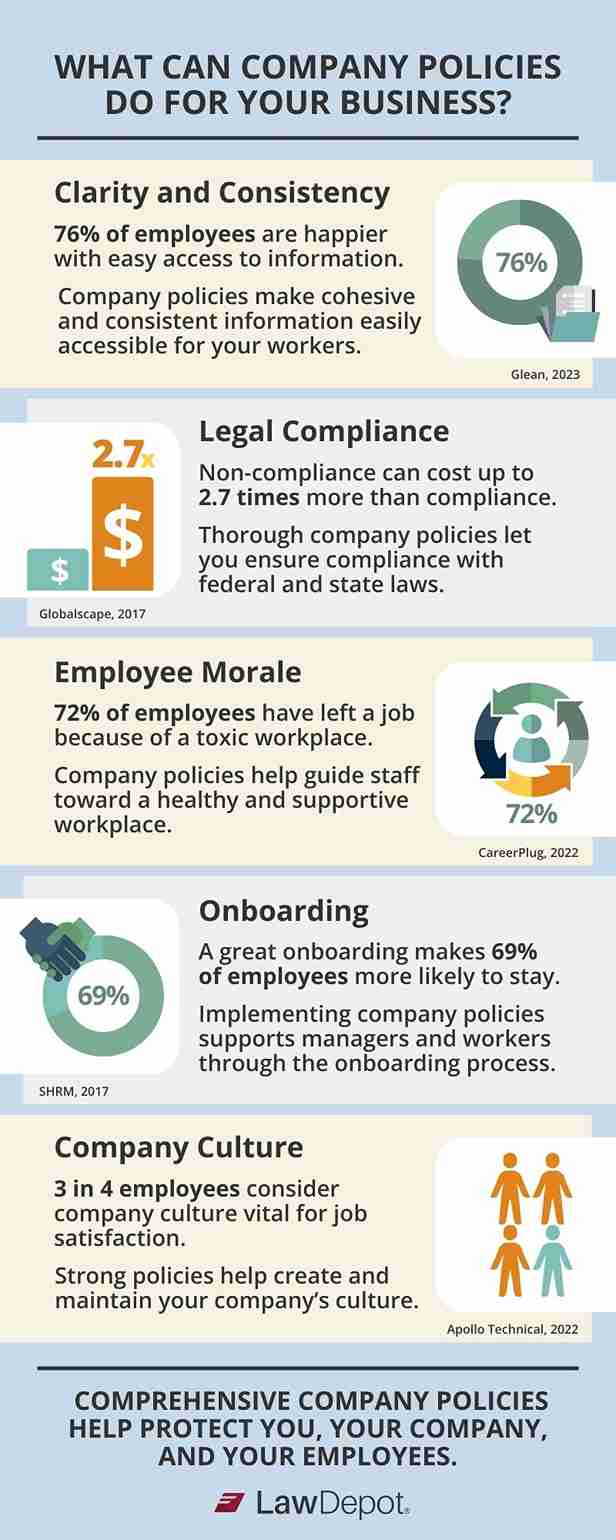
Table of Contents
Whether you already have employees or are considering hiring, you know that your workers’ safety and morale are vital to your business. Without workers, a company can’t perform as it needs to. To keep your company growing, you want to ensure employee retention, a healthy company culture, and a work environment that’s safe and secure for everyone.
Creating strong company policies lets you support your workers, protect your business, and ensure legal compliance. Read on to find out how.
What are company policies?
Company policies are a business’s rules and guidelines for internal use. They outline expectations and requirements for behavior, performance, and accountability. In addition to functioning as internal guidelines, company policies also ensure compliance with federal and state laws.
But your policies aren’t only going to deal with setting defined rules. Simon Bacher, the founder of language learning app Ling, learned much about company policies as his team grew. One of the lessons he picked up was that “an effective policy is less about control and more about guiding your team towards the company's mission.”
Your company policies are closely tied to your company culture and values. These are three vital parts of the work environment that can make the difference between retaining and losing good employees.
How do procedures relate to policies?
Managers and workers rely on company policies to learn how to handle workplace situations consistently. While policies are the overarching rules, procedures are the steps you need to take to follow the policy.
For example, a Remote Work Policy outlines the rules for remote work. These rules contain information about:
- Which employees can work remotely
- What equipment they’ll need
- How often they’ll need to come into the office
The policy also describes the procedure for requesting remote work. The procedure will include information such as:
- Who to contact
- What information to give them
- How the request will proceed from that point
Essentially, company procedures give employees the information they need to follow the company policies.
Who creates company policies?
Human resources departments often develop company policies, but many smaller businesses don’t have delegated HR workers. You can choose to outsource the work to a third-party consultant if you don't have an HR department.
However, because they are so closely related to company values, policies are often best created in-house. Consider assigning the task to a manager or yourself. This way, your policies will be informed by the existing company culture.
You should also involve your employees in the policy-making process. Anna Williams, HR director at Digital Silk, knows the importance of including workers. She recommends engaging workers because “their input can make these policies more solid, comprehensive, and in tune with actual workplace needs.”
Why are company policies so important?
When you create company policies for your organization, you set yourself and your employees up for success. The policies can protect your company, help with legal compliance, and offer guidance for your employees and managers.
By stating your company's standard practices, you can guide your workers through handling complex situations like discipline, harassment, and safety issues. The policies also support management in making fair and reasonable decisions.
According to Eugene Klimaszewski, founder of Mammoth Security, company policies are essential for the day-to-day operations of a team. “These guidelines not only make our processes more efficient but also protect us and our employees by providing clarity and setting expectations,” he says.
Company policies can help your company with
- Legal compliance
- Clarity and consistency
- Risk-management
- Decision making
- Company culture
- Employee morale and retention
- Communication and onboarding
Early implementation of company policies can ensure success in the future, and start-ups should begin early to build a strong foundation. Good policies will let your company remain robust and flexible as you grow.

What are the regulatory requirements for company policies?
Your company must comply with labor laws at the state and federal levels. When you create your company policies, you’ll need to be aware of and in compliance with the following federal legislation:
| The U.S. Department of Labor has created an Employment Law Guide to simplify navigating federal labor laws. Use this guide to more easily access and understand federal legislation when writing your company policies. |
State labor laws are put in place by State Labor Offices. Some of the areas a state has jurisdiction over are:
Many businesses choose to create policies that build upon existing legislation, often to offer further guidance to employees. However, it’s important to note that a company policy will never override the law.
For example, your company needs to follow the Occupational Safety and Health Act to ensure the safety of its workers. You'll build upon this legislation when you create your health and safety policy. You can also implement additional health and safety guidelines for your employees.
You might be legally required to create certain policies depending on your company’s industry, size, and location. Check with your state’s labor office or speak with a lawyer about what requirements your company needs to meet.
Policies every company should have
In addition to meeting any legal requirements, a start-up should focus on creating guidelines for the following areas:
- Employee management
- Codes of conduct
- Health and safety
- Privacy and security
Employee management

Your company should establish clear employment policies to help employees do their best work. These policies create the framework for how things work, making it easier for workers to navigate the company structure.
An Employee Handbook is invaluable for onboarding and should contain key company policies and procedures. Use the handbook alongside a New Hire Checklist to ensure new hires receive all the necessary information.
Create attendance, vacation, and time off policies so new hires have that information easily accessible. If your company has remote employees, use a Remote Work Policy to outline expectations and requirements for employees working from home.
Establish workplace expectations with a Progressive Discipline Policy. A discipline policy improves communication between management and staff. It outlines what behavior an employee can be reprimanded for and the corresponding disciplinary actions that may be taken.
Conflict resolution and employee complaints policies also help handle internal issues.
Codes of conduct

Employee codes of conduct build your company culture by outlining the desired behavior you want from your workers. You can also create separate policies for specific issues you wish to address, such as an expense policy or a cell phone policy.
If you want to set guidelines for employee behavior online, you can create a Social Media Policy. This policy protects your brand by setting clear expectations for how employees should represent the company and conduct themselves on social media.
Your company’s harassment policy helps create a safer work environment for all employees by clearly communicating what constitutes unacceptable behaviors. Alongside an equal opportunity policy, it can guide managers to develop a diverse and discrimination-free company culture.
Health and safety

A Health and Safety Policy protects workers from occupational hazards and proactively prevents injuries and accidents.
The Occupational Safety and Health Administration (OSHA) has existing guidelines for most industries. However, it's critical to have a unique and specific policy that suits your company's needs.
Privacy and security

Strong privacy and security policies will not only help keep your business safe. Employees also value privacy and security, and by creating policies that protect and support them, you can earn their trust and confidence.
Employers collect and keep employee information, such as contact information, salary, performance review notes, and Social Security Numbers. An Employee Privacy Policy outlines how this information will be collected, stored, disclosed, and disposed of.
Since most companies rely on online tools for work and marketing, a data security policy will help manage and protect online data. It will also outline how to avoid a security breach and how to deal with it if one occurs. Similarly, a confidentiality policy outlines confidentiality in the workplace and the process for handling leaked information.
If your company allows employees to bring in their own electronics for work-related purposes, consider creating a bring-your-own-device policy. On the other hand, if you supply company devices, a company device policy might come in handy. These policies set additional guidelines to avoid data breaches, such as what employees can or can’t use their devices for.
Creating company policies
To build a strong foundation for your business, you should start creating company policies early. Once you begin hiring employees, your policies will offer you structured support and guidance so you can remain consistent and firm in your decision-making.
Hayim Grant, president and founder of Corporate Suites, says his primary advice for creating company policies is “to be clear, concise, and inclusive.” When you write your policies, ensure you cover all the necessary scenarios and use easy-to-understand language.
Creating policies can look different from company to company, but establishing a step-by-step practice can be helpful. As the head of Mammoth Security, Klimaszewski has found the following structured approach helpful when creating policies for his company:
- Pinpoint the need for a policy or revision
- Write a draft with insight from team leaders
- Check compliance with a legal review
- Gather feedback from the team
- Officially adopt the policy
Communicating policies to employees
Properly communicating company policies to your employees is as critical as creating them. Since your staff can’t follow guidelines they aren’t aware of, you should always make policies easily accessible for all workers.
“It's not enough to simply distribute a policy manual,” says Michael Ashley, founder of Ashley Insights. Drawing on his experience as chief of staff at Wells Fargo, he stresses the importance of making policies accessible in multiple formats. Training sessions and open forums are equally important as physical and digital policy copies.
Take these steps to inform your employees of your company policies:
- Provide new hires with copies of policies during their onboarding or orientation period
- Physically display policies in breakrooms or hallways
- Display policies digitally on the company intranet
- Conduct regular training and reviewing sessions for all staff
Enforcement of company policies
A violation of a company policy should have consequences. Even if your company doesn’t have a discipline policy, all your policies should clearly state the consequences of breaking them. These consequences could include:
- Clarification of the policy
- Reprimanding
- Removal of perks
- Added restrictions or supervision
- Warnings (verbal/written)
- Suspension or termination
Consistent and fair consequences are imperative when a policy breach occurs. In a 2022 study by Career Plug, employees ranked more accountability for policy violations as the fourth-best action employers could take to create a more positive work environment. While your policies should allow for flexibility and empathy, managers also need to apply the rules diligently.
To achieve a balance of clarity and flexibility, Ling-founder Bacher says that employees should understand the purpose of the policies instead of blindly following the rules. Explaining why policies exist, what they contain, and how to follow them will help your team understand how they align with company values.
Drawing on her years of experience as HR director at Digital Silk, Williams suggests the following key steps for handling a policy breach:
- Identify the breach
- Communicate directly with the involved party
- Review procedures to prevent future misunderstandings
Reviewing and updating your company policies
After creating your company policies, it’s crucial to review them regularly. Legal requirements and business goals might change, so you should revisit and refresh your policies often to ensure compliance and cohesiveness.
Williams emphasizes the importance of reviewing and updating your policies: “Policies should evolve as your business does. Regular revisions help keep them aligned with changes within businesses and broader trends.”
It can also be a good idea to have employees review the policies so that they stay fresh in their minds. Making this a part of your yearly to-do list can help with awareness and enforcement of the policies.
Your policies create the frameworks of your decision-making and are crucial to your business management. Without updated policies, your company might struggle to expand and grow. Give yourself and your company a leg up by creating solid and comprehensive policies that let you and your employees continue to evolve.


